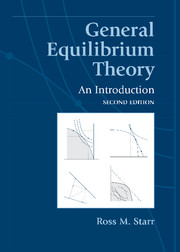Book contents
- Frontmatter
- Contents
- List of illustrations
- Introduction to the second edition
- Preface to the second edition
- Preface to the first edition
- Table of notation
- Table of assumptions
- A General equilibrium theory: Getting acquainted
- B Mathematics
- C An economy with bounded production technology and supply and demand functions
- D An economy with unbounded production technology and supply and demand functions
- 15 Theory of production: The unbounded technology case
- 16 Households: The unbounded technology case
- 17 A market economy: The unbounded technology case
- 18 General equilibrium of the market economy: The unbounded technology case
- E Welfare economics and the scope of markets
- F Bargaining and equilibrium: The core
- G An economy with supply and demand correspondences
- H Standing on the shoulders of giants
- Bibliography
- Index
15 - Theory of production: The unbounded technology case
from D - An economy with unbounded production technology and supply and demand functions
Published online by Cambridge University Press: 05 June 2012
- Frontmatter
- Contents
- List of illustrations
- Introduction to the second edition
- Preface to the second edition
- Preface to the first edition
- Table of notation
- Table of assumptions
- A General equilibrium theory: Getting acquainted
- B Mathematics
- C An economy with bounded production technology and supply and demand functions
- D An economy with unbounded production technology and supply and demand functions
- 15 Theory of production: The unbounded technology case
- 16 Households: The unbounded technology case
- 17 A market economy: The unbounded technology case
- 18 General equilibrium of the market economy: The unbounded technology case
- E Welfare economics and the scope of markets
- F Bargaining and equilibrium: The core
- G An economy with supply and demand correspondences
- H Standing on the shoulders of giants
- Bibliography
- Index
Summary
Unbounded production technology
We will introduce here a model of firms and production decisions that is formally identical to the model introduced in Chapter 11, except that we omit the assumption of boundedness of production technology (P.VI). Remember why we need boundedness. Sufficient conditions for well-defined optimizing behavior include a compact (hence, bounded) opportunity set. We will introduce a weaker assumption (P. IV) and show that the set of attainable allocations is still bounded.
Our modeling plan is to reduce the study of general equilibrium in the economy with unbounded technology sets to the case of bounded technologies introduced in Chapters 11–14. We will define an artificially restricted firm sector consisting of the unbounded production technologies restricted to a bounded subset that includes their attainable portions as a proper subset. Of course, actual equilibria and successful production plans have to be located in this attainable region, but the inducement of firms to choose to operate there should not be from exogenous constraint; it should be the result of incentives provided by the price system. We will show this to be the case in the equilibrium of the artificially bounded firm sector using Lemma 14.1. In equilibrium, artificial bounds on production will not be a binding constraint.
We now (re)state a generalized form of the model of the production sector introduced in Chapter 11. In the notation here, a Roman “Y”, Yj, is used to denote the (possibly) unbounded production technology, substituting for the script “Y”, Yj, that denoted a bounded production technology.
- Type
- Chapter
- Information
- General Equilibrium TheoryAn Introduction, pp. 164 - 173Publisher: Cambridge University PressPrint publication year: 2011



